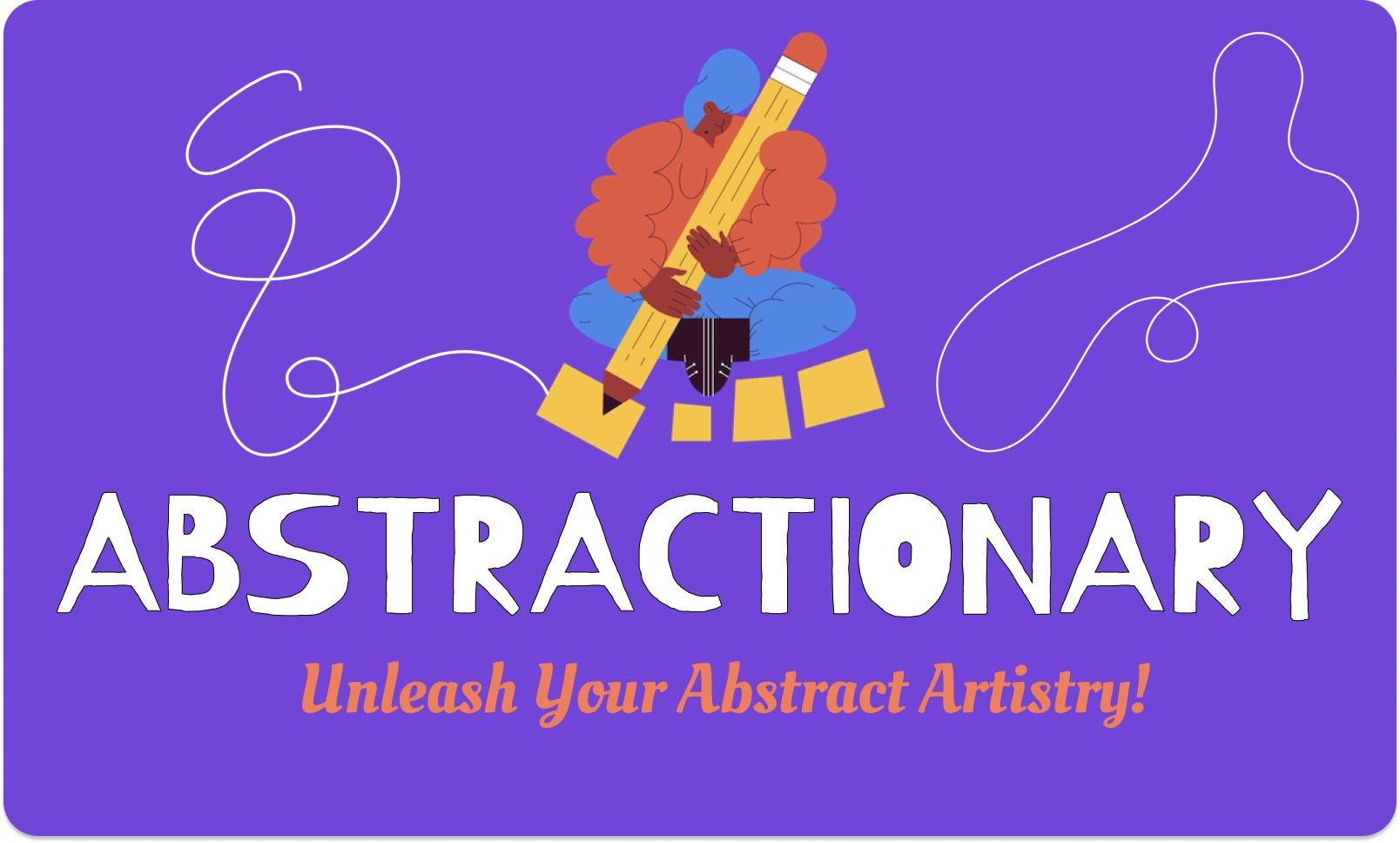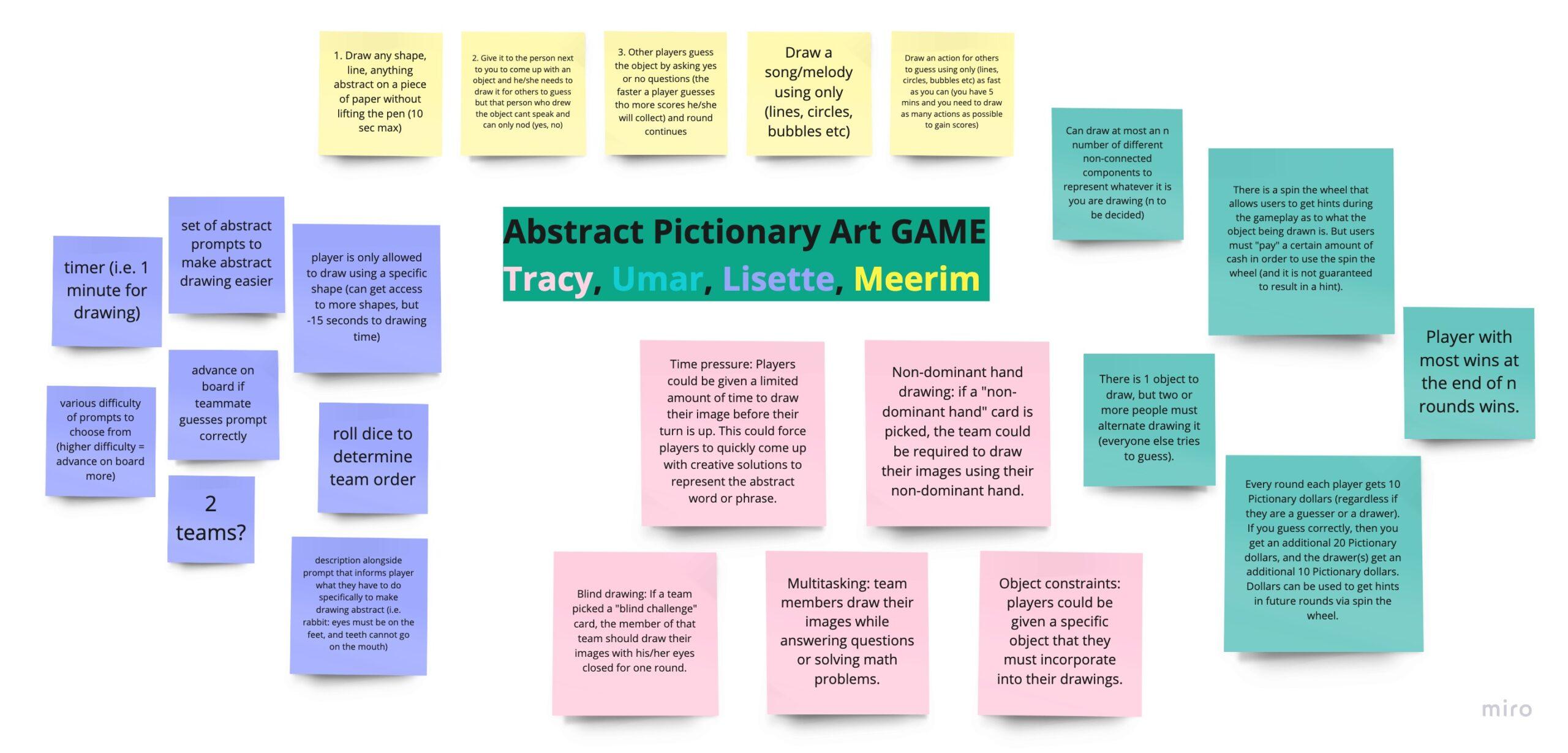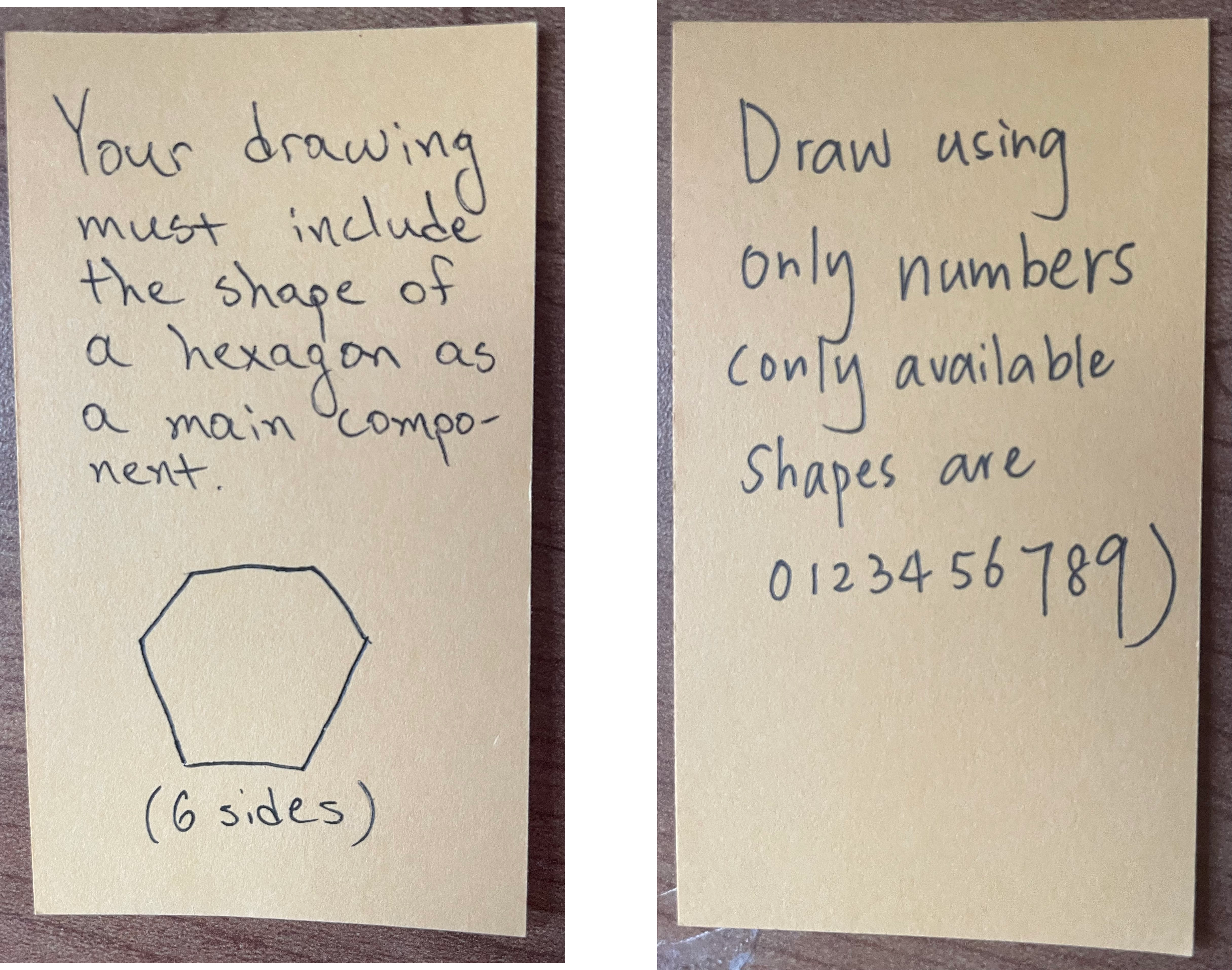Created by Tracy Luan, Lisette Malacon, Meerim Nurlanbekova, Umar Patel
Artist’s Statement
Pictionary is a fun and thrilling game in which teams eagerly try to guess an unknown drawing, aiming to be the first. Our goal was to change some of the main mechanics of both the drawing and guessing actions within the game in order to convert Pictionary into a more Abstract drawing and guessing game. To change the dynamic of the drawing part, we incorporated a twist to the drawing process by including “Abstraction” cards, which put an additional restriction on the drawers that make the process of drawing not only more challenging, but also more abstract. We’ve also included “DRAWback” cards which are enacted once an incorrect guess threshold is met by a team, and make either the drawer or guesser’s task more difficult, depending on what the “penalty” is. The penalty could also be an additional abstraction! Ultimately, the Abstraction cards force drawers to think differently in how they must represent their object and find ways to convey meaning from explicit drawings. And adding such penalties and challenges would lead to a more methodical and intentional guessing approach for the guessers (instead of the “first-come-to-mind” fast-paced guessing approach). There’s also Abstractionary Shapes which can buy a team a hint when guessing. Overall, such changes allow for a more abstract and methodical approach to a drawing game that still maintains the energy and suspenseful guessing approach that Pictionary aims for.
Concept Map
Final Concept

Original Ideation
Initial Decisions About Formal Elements & Values
Abstractionary, a social drawing and guessing game, combines creativity, teamwork, and competition in a thrilling experience that caters to a variety of player preferences. In this section, we will discuss our initial decisions about the game’s formal elements and how they align with the different types of fun that players may seek.
Formal Elements of Abstractionary
- Players: Abstractionary is a team-based game, pitting two teams of 4-10 players against each other. This format encourages cooperation and communication within the teams while maintaining the competitive aspect between them.
- Objectives: The main objective in Abstractionary is for the teams to correctly guess the object being drawn by their respective drawers, adhering to various abstractions and constraints. The first team to reach five points wins the game.
- Outcomes: Abstractionary is a non-zero-sum game, with both teams having the potential to score points in each round. This format allows players to focus on improving their team’s performance rather than purely dominating the opposing team.
- Rules: The game’s rules establish the framework for gameplay, including the use of prompt cards, abstraction cards, and Abstractionary dollars. The rules also specify the limitations on guessing and the use of hints.
- Procedures: Abstractionary’s gameplay consists of a series of rounds, with drawers rotating each time. Rounds are timed, and each team’s performance in a round determines whether they earn points and Abstractionary dollars.
- Resources: Abstractionary incorporates several resources that influence gameplay, such as the prompt cards, abstraction cards, drawing surfaces, drawing tools, and the timer.
- Boundaries: The boundaries of Abstractionary are defined by the game’s rules and objectives. Players must stay within these boundaries to maintain a fair and engaging gaming experience.
Core Aesthetics and Types of Fun in Abstractionary
- Sense Pleasure: Abstractionary offers visual stimulation through the creative drawings and the use of paper and pens. Players can derive enjoyment from witnessing the imaginative ways drawers represent objects under the imposed abstractions.
- Fantasy: While not the primary focus, Abstractionary does allow players to step into the role of a drawer, allowing them to briefly explore their artistic side.
- Narrative: The game does not have a strong narrative element, but the drawings and guesses can lead to humorous moments and memorable stories shared among players.
- Challenge: Abstractionary’s core challenge comes from interpreting the drawings under various constraints and guessing the correct object within the time limit. This dynamic aspect keeps the game engaging and tests the players’ adaptability.
- Fellowship: As a team-based game, Abstractionary fosters fellowship by encouraging cooperation, communication, and shared decision-making among teammates. The game’s collaborative nature satisfies the players’ desire to work together towards a common goal.
- Competition: Abstractionary provides a competitive outlet as teams vie for points and strive to outperform their opponents. The game caters to players who enjoy demonstrating their superiority in problem-solving, creativity, and teamwork.
- Discovery: The game offers opportunities for discovery in the form of unique abstractions and unpredictable drawings. Players can enjoy the challenge of deciphering these elements and uncovering the object in question.
- Expression: Abstractionary allows players, especially the drawers, to express their creativity and problem-solving skills. They can showcase their artistic abilities while adhering to the game’s constraints
- Abnegation: The game serves as a pastime that allows players to disengage from daily concerns and immerse themselves in a fun, cooperative, and competitive experience.
In conclusion, we hope to design Abstractionary as a social game that skillfully incorporates various formal elements to create an engaging and enjoyable experience for its players. By combining team-based competition with creative expression and problem-solving, the game caters to a wide range of player preferences and types of fun.
The game’s mechanics foster cooperation, communication, and adaptability among teammates, while also maintaining a competitive atmosphere that keeps players motivated to perform their best. Additionally, the use of resources like prompt cards and abstraction cards add an element of unpredictability and discovery, which further enhances the gameplay experience.
Furthermore, we want to make Abstractionary be appealing to players who enjoy different types of fun, such as sense pleasure, challenge, fellowship, competition, discovery, expression, and abnegation. The game’s ability to cater to various tastes makes it a versatile and inclusive choice for social gatherings, parties, or casual get-togethers.
The initial decisions regarding the game’s formal elements and values have successfully created a cohesive and entertaining experience that can be enjoyed by a diverse range of players. Abstractionary serves as an excellent example of how thoughtful design and consideration of player preferences can lead to a captivating and memorable gaming experience.
Testing & Iteration History
Playtest #1
Our first playtest aimed to explore how players would react to the initial design and gameplay decisions of our game. Four Stanford students playtested our game, resulting in teams of size two. We opted for 90 second rounds.
Some initial questions:
- How does the mechanic of teams drawing and guessing simultaneously impact the player and team dynamics as well as the overall environment/mood of the game? Does that mechanic support our aesthetic of fellowship that we envision?
- How will hints impact the outcome of the game? Do they provide an unfair advantage that makes it impossible for the losing side to come back from?
- How do Abstraction cards impact fun?
The Good:
Because each team received paper to draw on, it was easy for teams to focus on their own drawings and guesses. This supported strong fellowship within teams as teammates worked together to be the first to guess correctly, but it was difficult for players to know what was happening across teams. We knew that we wanted to keep the mechanism of teams drawing and guessing simultaneously in order to preserve the strong sense of competition that we observed, but how could we achieve this while also supporting visibility across teams? (see Playtest #3 for how we addressed this!)
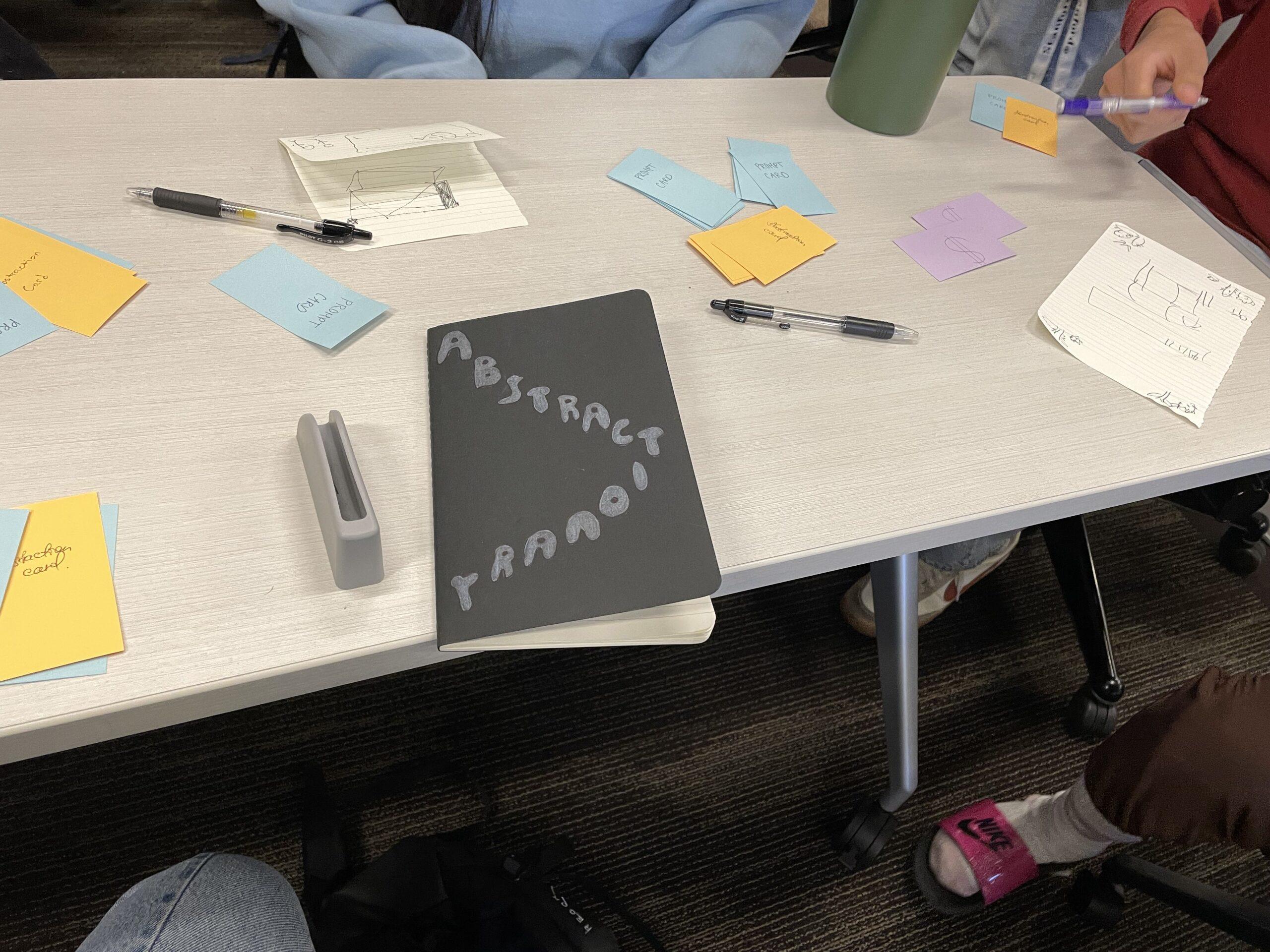
Based on verbal feedback, the drawing restrictions imposed by Abstraction cards were adequately challenging. Drawers would physically and sometimes audibly laugh/groan to the description of the card, which we took as a good sign because a groan indicates a challenge while the laugh indicates that it’s still enjoyable for players. Furthermore, there was no confusion with the drawing prompts (i.e. Piano) we tested.
Room for Improvement:
Some players may not understand what a certain Abstraction is looking for. For example, one Abstraction card asks that players incorporate a hexagon in their drawing. One player said that they forgot how many sides a hexagon has, making this Abstraction challenging in an unnecessary way. To make the game challenging in a fair way, we changed this card, as well as other potentially unclear cards, to make it clear what a hexagon looks like:
Regarding hints, our initial intention was that hints be bought before a round starts. However, we noticed that players would purchase hints in the middle of rounds once they realized they were having extra difficulty guessing the drawing. We realized that this action is more desirable to players and adjusted our rules based on this behavior.
The hints bought during this playtest did not seem to unfairly impact the balance of the game, due to the fact that the hints bought were not too revealing, such as the hint for Aquarium being “a large container”. However, how much each hint reveals may vary from hint to hint. This is something that we intentionally looked out for in future playtests.
Playtest #2
Because a large part of Abstractionary is understanding how players like the Prompt cards and Abstraction cards we give them, our second playtest intentionally used prompts and abstractions that hadn’t been used in the first playtest. We also applied the gameplay updates described in Playtest #1. Once again, four Stanford students playtested our game, resulting in teams of size two. We changed the time limit per round from 90 seconds to 60 seconds because the round time limit was never reached during Playtest #1.
Some questions:
- How did players react to the Abstraction cards they drew?
- How did players interact with the hint mechanism? Did they tend to buy hints before a round started, or did they buy them in the middle of a round?
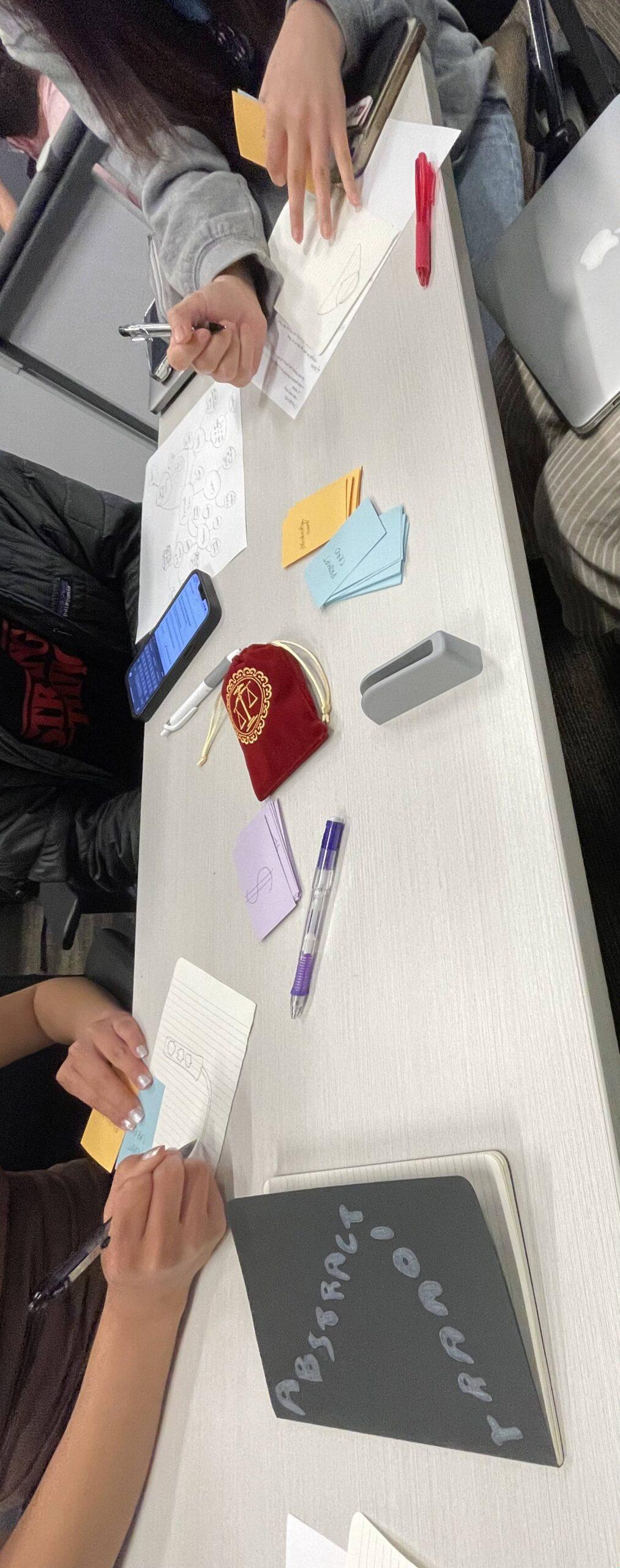
The Good:
One player told us that they normally don’t like games like Pictionary, but the Abstraction cards made the game much more fun since it’s not about skill; it’s about being able to draw something that others can understand despite the restrictions, which we think helps facilitate the aesthetic of expression. “It’s good for people who suck at drawing.”
We also saw a mix of when hints were bought. Sometimes they’d be bought before a round started, while other times they’d be bought in the middle of a round. We believe that players appreciate this flexibility, so we’ll continue to allow this mechanism. One player noted that they like being able to buy hints because that adds another mechanic to the game: deciding when is the best time to buy a hint using the Abstractionary dollars they’ve earned from winning previous rounds.
Room for Improvement:
One of the biggest red flags we observed was that sometimes teammates guessed a prompt correctly before the drawer had even incorporated the Abstraction card into their drawing, which defeated the whole premise of our game! For our final playtest, the moderator emphasized that drawers must follow the restriction specified by the Abstraction card immediately. Players also suggested that teams could lose an Abstractionary dollar if they fail to follow their Abstraction card.
Even after lowering the time limit to 60 seconds, it was never met. We suspect that this was because teams have unlimited guesses, which makes it easy to guess the drawing correctly quickly.
Our players also mentioned that some Abstraction cards were much harder than others: it’s really hard to draw with your eyes closed, whereas you can still easily convey what the object is when you’re restricted to using only half the drawing area. How can we make this mechanic fairer?
Changes Made Based on Playtest #2 Results & CA Feedback (thank you Krishnan!)
To make Abstractionary not feel too similar to Pictionary, we blended our CA’s feedback with what we observed in Playtest #2, resulting in the invention of DRAWback cards.
Remember how players would rapid-fire guess their teammate’s drawing and win a round within a few seconds? This is also a trait of Pictionary, but we realized that it’s not a great trait for Abstractionary, a game that intends to facilitate the aesthetics of challenge and expression. It’s not challenging if a drawing can be guessed in 5 seconds, and drawers don’t even get a chance to fully express themselves when not granted enough time to draw.
So, we made DRAWback cards. Similar to Abstraction cards, DRAWback cards impose another restriction that drawers must adhere to. DRAWback cards are a penalty for reaching a certain number of incorrect guesses. For example, if a team makes 3 incorrect guesses, everyone pauses, and that team must draw a DRAWback card and follow its restriction. The incorrect guess count resets after a DRAWback card is drawn. A maximum of 2 DRAWback cards may be drawn per round. We believe that this mechanic makes the game more challenging for guessers, influencing guessers to be extra thoughtful with their guesses, while also granting the drawer more time to express themself in their drawing. Because we expect rounds to take much longer, we increased the time limit per round back to 90 seconds. Furthermore, to enforce that Abstraction cards are actually followed unlike in previous playtests, if the drawer fails to follow an Abstraction during their turn, they must draw a DRAWback card to follow for the next turn.
To make the game fairer amongst drawers, we tested out the mechanic of having both teams’ drawers follow the same Abstraction card. One Abstraction card is drawn per round and read aloud. Not only is it fairer that drawers face the same challenge, but we also hoped that the guessers might have a fun reaction to hearing what Abstraction their teammate had to follow.
Playtest #3: The Final Playtest
Our final playtest incorporated all of the changes mentioned in the previous section. Ultimately, we wanted to find out how these changes affected gameplay, player experience, and our intended types of fun. Eight Stanford students playtested our game this time, resulting in teams of size four. We used a shared whiteboard as the drawing surface instead of individual sheets of paper.

Some questions:
- How will DRAWback cards and their associated rules affect gameplay and player dynamics?
- Is using the same Abstraction card for both teams an improvement in terms of fairness and fellowship across teams?
- Similarly, does using a whiteboard as the drawing surface facilitate fellowship across teams?
The Good:
The DRAWback card mechanic definitely transformed the dynamics of the game. We noticed players being careful with their guesses. For the first time, we saw guessers discussing amongst their teammates before making an official guess. Drawers had more time to build their creations. While we were concerned that the new mechanic would make the game too hard, most times the drawing was guessed correctly before a DRAWback was enacted. 90 second rounds worked great for this new mechanic, because it granted enough leeway for players to take their time in guessing while also acting as a solid cap. The 90 second limit was reached once during this playtest.
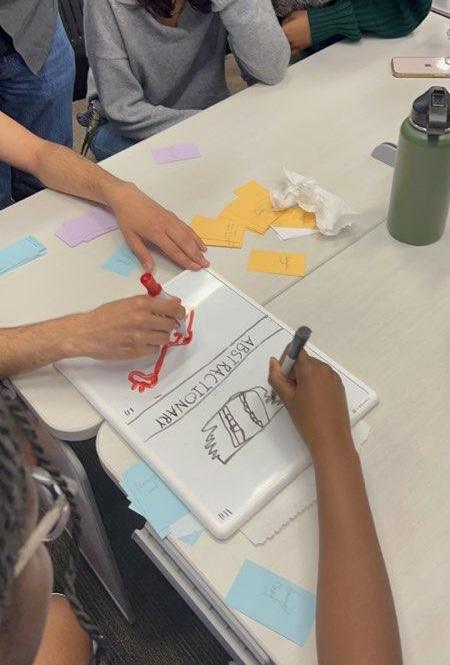
The whiteboard was a HUGE improvement to paper. Players could easily focus on their teammates’ drawing right in front of them, but they could just as easily look at the opposite side of the board to see what the other team was up to. This proximity enabled teams to easily tell how the opposing team’s drawer and when someone guessed correctly first.
Finally, using the same Abstraction card also worked great. There were no remarks about unfairness. When asking players what they thought about teams following the same Abstraction, they agreed that it worked well.
Room for Improvement:
We discovered that some hints were too revealing: one team bought the hint for Piano, which was “88 keys”, and they guessed the drawing correctly before the drawer even completed a stroke.
Some players thought that “pausing” the game when a team received a DRAWback card didn’t actually pause the game because guessers could still look at the drawing and think about what it was.
Lastly, we discovered that 3 incorrect guesses before receiving a DRAWback card may have been too restrictive. Part of the fun is in the freedom of guessing.
Final Changes
Based on the results of our Final Playtest and final CA feedback, we made the following changes to Abstractionary.
We increased the number of incorrect guesses required to receive a DRAWback card from 3 to a number proportional to the number of guessers on a team. For example, if there are 3 guessers on a team, then 9 incorrect guesses are allowed, 3 per guesser. Hopefully, this results in the right balance of challenge while also allowing the drawer time to express themself in their drawings!
To make the pausing mechanic feel more like a true pause, we updated the rules to instruct players to cover the drawing surface during the time a DRAWback card is drawn and read.
We changed the design of our cards from typical playing cards to a a design that better fits the premise of our game: paper and abstract drawings.
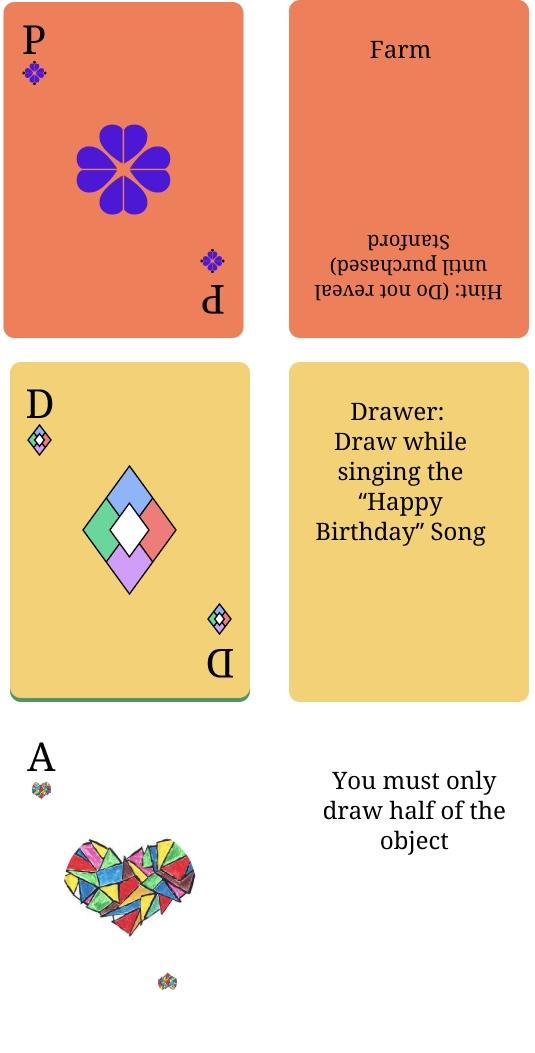
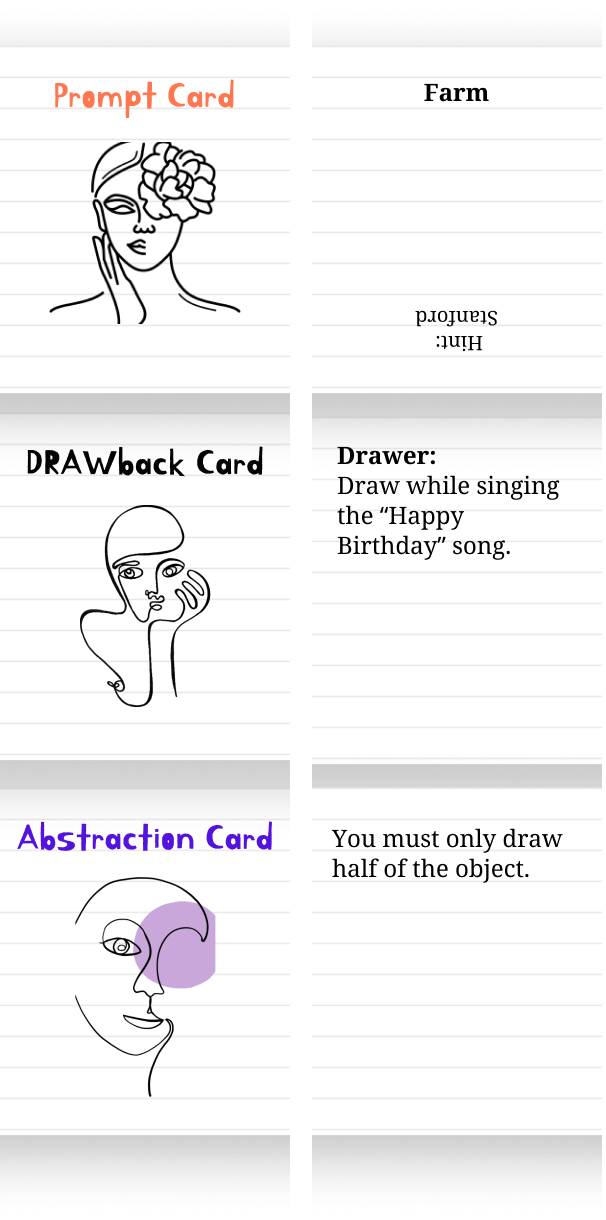
We also changed money to a resource that better fits the premise of our game: shapes! Abstract art commonly uses shapes, so Abstractionary Shapes are a valuable currency for Abstractionary:
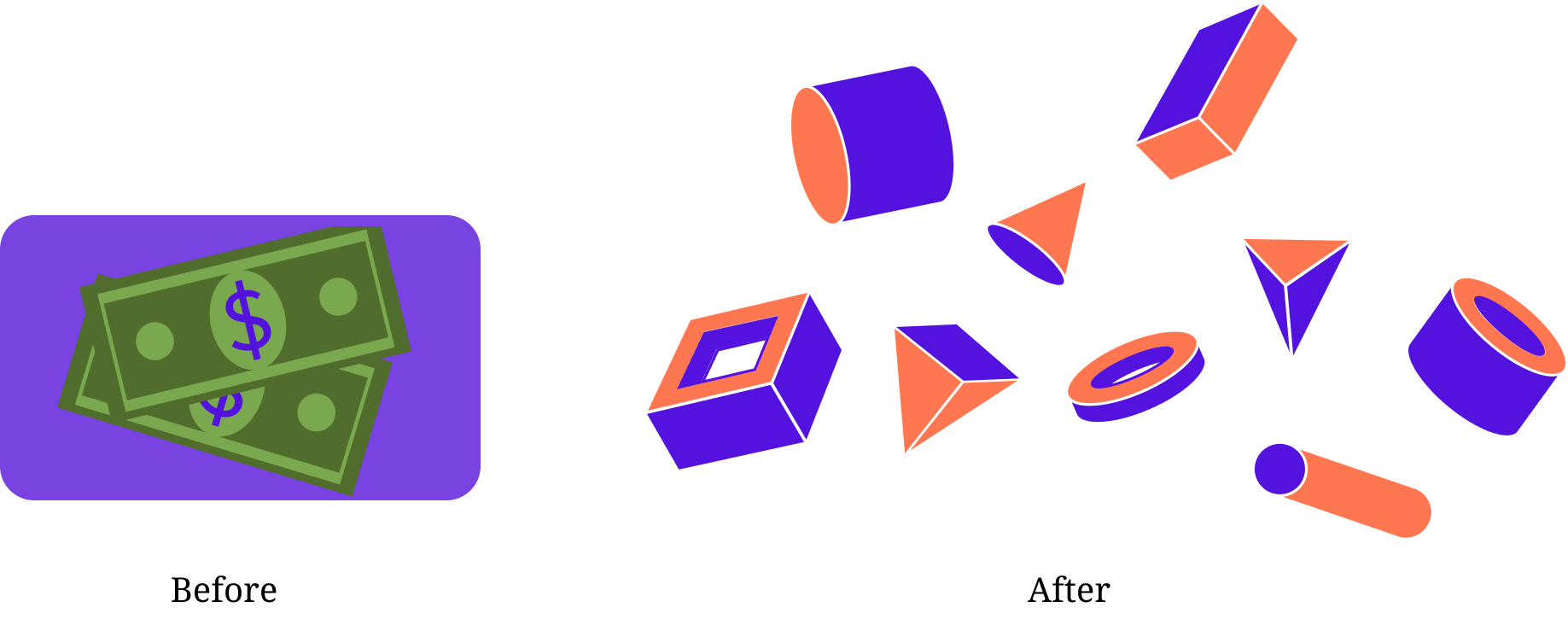
Finally, we re-evaluated each hint on our Prompt cards, making them less revealing by ensuring the hint can apply to multiple objects in the universe (i.e. changing the hint for Muffin from “a breakfast cupcake” to “a breakfast item”, narrowing down the scope of answers somewhat but not completely).
Final Playtest Video
Abstractionary Print-n-Play
https://drive.google.com/file/d/1iD_IfkcCgZ5SZsrFgKWEc1CWX6wppvEk/view?usp=sharing
Have fun!


